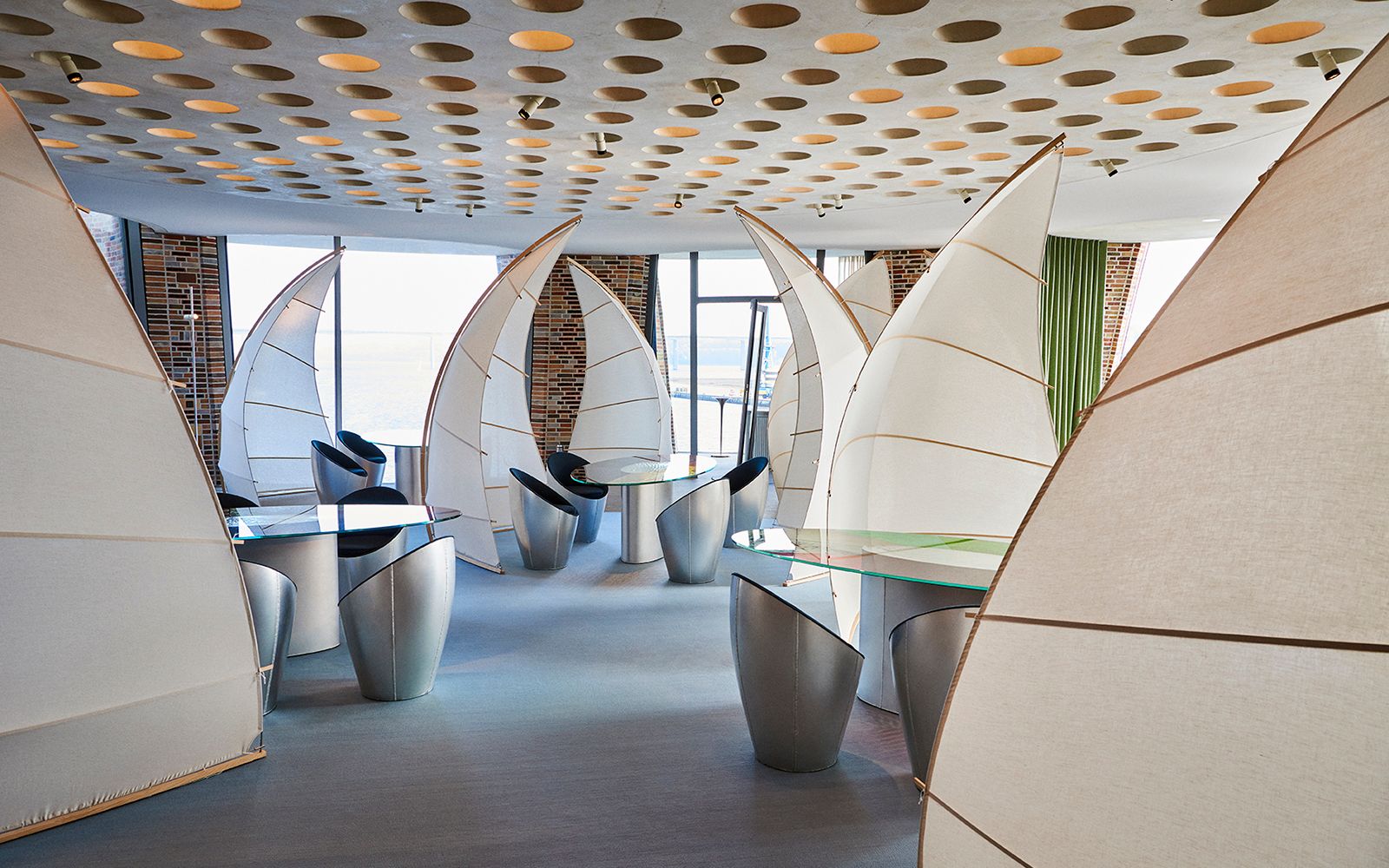
Lyst Restaurant
Vejle, Denmark 2019
The restaurant Lyst is situated in the iconic Fjordenhus building in Vejle, Denmark. It was founded by Morten Kirk Johansen and has been developed in close collaboration with Studio Other Spaces. Fjordenhus, designed by Olafur Eliasson and Sebastian Behmann, opened in 2018 and was inspired by the immediate surroundings of Vejle, which gave shape to the building. The fjord flows directly through the building; the wind, water, harbour, land, and changing weather are constantly present.
For Lyst, the architecture of the building acted as a catalyst of the cuisine, and the food, in turn, inspired the design of the restaurant. Studio Other Spaces developed the space, furniture, lighting, and eating utensils to emphasise the relationship between the fjord, the building, the food, and the people using the space. Through several interdisciplinary workshops with Morten Kirk Johansen along with chef Daniel McBurnie and his dedicated kitchen team, Studio Other Spaces formulated a design language based on basic materials and production methods, and the way cooking with simple ingredients can achieve unique results.
production

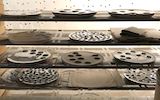
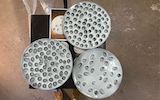
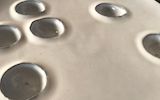
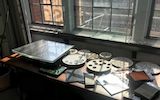
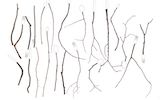
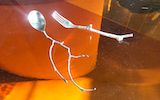
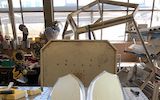
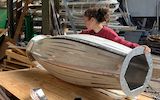
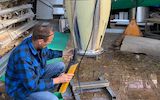
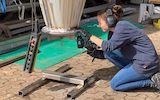
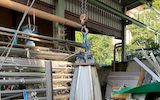
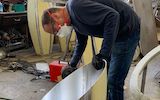
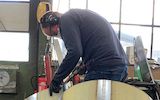
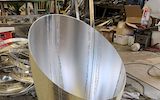
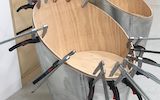
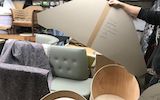
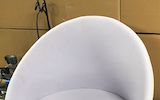
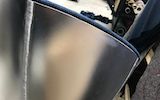
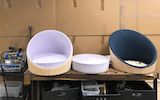
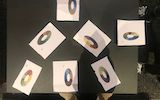
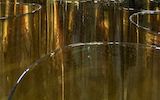

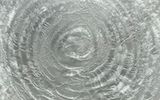
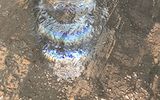
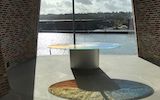
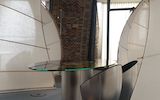
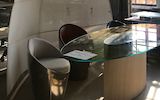
reality
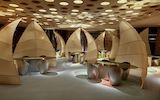














A visible process
The aim of the design of Lyst was to develop a language that corresponds with what unfolds in the restaurant's kitchen – to transfer into the design process the way raw materials are used in the kitchen. High-quality ingredients and simple recipes can deliver extraordinary results. Studio Other Spaces sought the parallel tracks between cooking and design, and how to process materials in a way that the design would become tangible. By emphasising the simple ways materials are combined and by reducing complexity, the production process becomes transparent. Rethinking and refining this process results in an unexpected aesthetic.
Sensitisation
The design of this contemporary restaurant represenst Lyst's food concept and supports the idea of interconnectivity. Historically, human actions have been centred on catering to the human species. Inevitably, this will shift: landscapes, non-human agents, climate, and so on are weighing more and more on decision-making. They will influence the way humans continue to occupy the planet, how to plan urban spaces, how to organise infrastructure, and how to think about architecture. The kitchen is the space where all ingredients – the food, the architecture, the humans, and the tools come together in collaboration. In that sense, it offers a quintessential example of interconnectivity; it is where food and architecture meet. Studio Other Spaces' goal for the Lyst restaurant design is to invoke a sensitivity to experiencing one's surroundings.
Interdisciplinary workshops
The restaurant concept is based on the four elements: water, fire, earth, and wind. The restaurant has been inspired by the building, and the original concept behind Fjordenhus was to enable an exchange between art and architecture, allowing one discipline to inspire the other. The interior of Lyst was realised with the same interdisciplinary approach, through workshops with the kitchen team. The kitchen team interpreted the building, and Studio Other Spaces in turn interpreted the kitchen's vision as the source of inspiration for the restaurant design. This collaborative effort resulted in a feedback system that bred overlaps between the two disciplines, which benefited from each other's strengths and diversity. Bolstered by this generative process, the design for Lyst aims at emphasising and creating awareness of the interconnectedness of elements, the building's environment, humans and other species, plants and nature.
Interior features
For each feature of the interior design for Lyst, there is a distinct elemental relationship. For example, the chairs have been designed in relation to water. They were made using hydroforming, a fabrication process that allows the shaping of different metals using highly pressurised fluid. Ellipsoids were fabricated that resemble the buoys in the harbour, and then each form was cut in half to make two chairs. So, the base of each chair has been given shape by the pressure of water. The expansion process of hydroforming is similar to the creation of the Indian bread Poori with hot air – both processes share an operational and elemental simplicity. Fjordenhus has the presence of a ship floating in the harbour. Looking out across the fjord from Lyst, one can see sailboats in the distance. The nautical sails in the interior design concept tie the interior of Lyst to the wind and waves just outside. They also operate as a tool to form spaces around the tables, mitigating a shift in scale from the vast drum-shaped room to the intimate, differentiated dining areas. Sharing a table with other guests is like being on a boat with a group, enveloped by a sail.
The glass panes that are used as the table tops have been hand-blown in different colours across the spectrum, emphasising the passage of light through the space. They provide a surface that functions somewhere between a table and a communal plate. The elliptical shape of the tables – echoing those of the volumes of the building itself – acts as both a dish and a roundtable, big enough to share among guests without the dining experience necessarily being separated by individual plates. Intended to make the diners' relationship to the cuisine more direct, food is taken from the grill and placed directly onto the tables, leaving out usual layers such as tablecloths or plates. The tables work together with the concept of the kitchen: focussing simply on the relationship between food, preparation, and guest.
The custom cutlery for Lyst have been literally taken from the wooded surroundings of the fjord. The owner of the building himself collected twigs and branches from around Vejle, which were then cast in brushed stainless steel as forks and a series of other novel and useful shapes. Together, these objects comprise a toolset that rounds out the elemental dining experience and further connects the diners to the landscape.
Client: Morten Kirk Johansen
Location: Vejle, Denmark
Date: 2019




